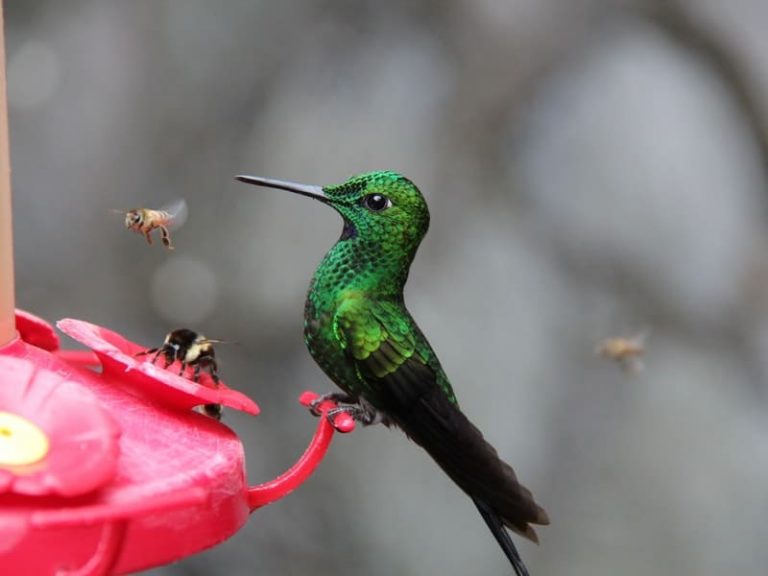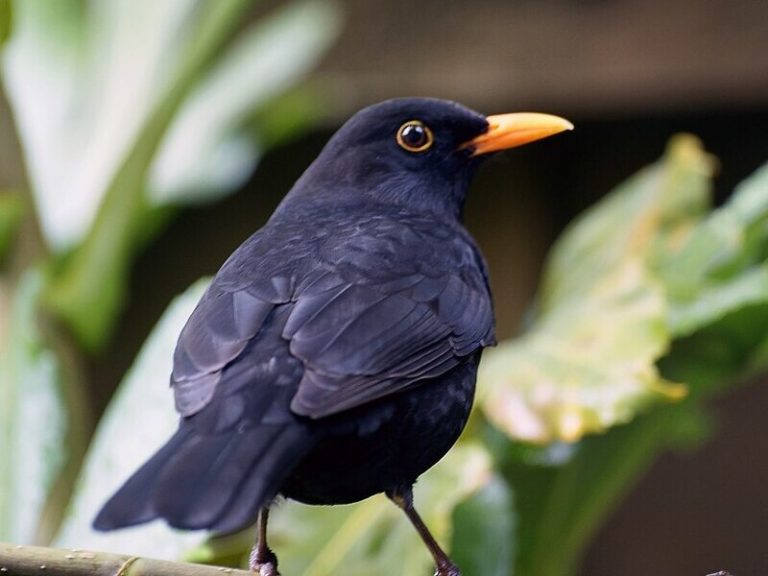When To Put Out Thistle Seed For Finches?
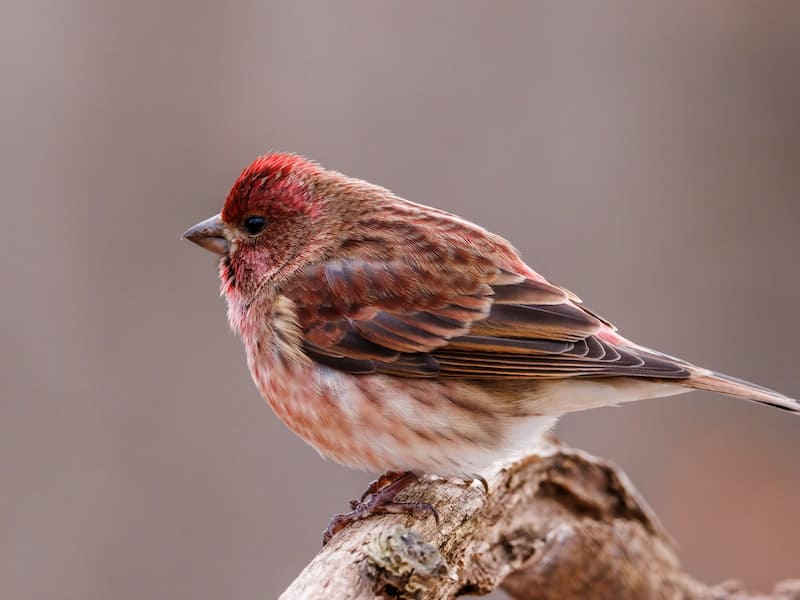
Thistle seed is an important food source for finches and other small birds. If you’re a bird lover, chances are you have seen or heard of the beautiful goldfinches or other such species that flit around your backyard in search of thistle seed.
Watching them peck away at the seeds can be quite mesmerizing, but have you ever actually tried providing this enticing treat to your feathered friends?
You may think it’s too complicated to get started, but with a few simple steps, it’s really easy to start offering these tiny treats and watching as your visitors increase, all thanks to one special ingredient.
Read on for our guide about when to put out thistle seeds for finches so that those beloved birds can enjoy its benefits all year round.
When to Put Out Thistle Seeds for Finches?
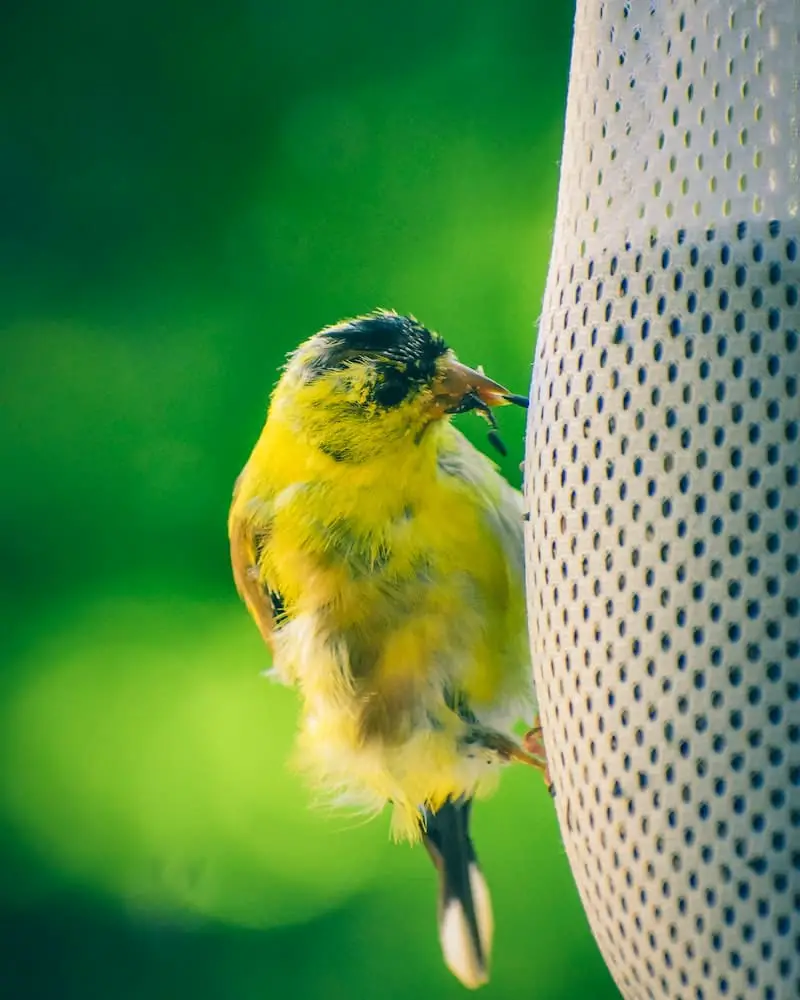
One of the best ways to attract beautiful finches is to put out thistle seeds. If you want finches to come to your yard and enjoy the special feeder in your garden, the best time to put out thistle seeds is during late autumn or early winter.
During these months, finches are preparing for their overwintering season, which means they still have enough energy to search for food, but their diet needs more nutritious options.
Thistle seeds provide a great source of fatty acids and other essential nutrients, as well as natural oils for extra warmth that helps them get through the cold winter days.
While it’s also possible to put out thistle seeds in summer if you want to attract finches, you may end up with outbreaks of other birds that can scare away your desired feathered friends.
If you want to know how long does it take for sparrow eggs to hatch or want to explore the types of birds that look like sparrows, check out our blog.
When to Put Out Finch Feeders If You Live in the North of the US?
For bird watchers living in the northern United States, putting out finch feeders can be a great way to attract a variety of colorful and small birds. The timing of when to put them out can depend on the climate you live in.
Generally, it’s best to wait until mid to late September if you live in or near New England or the Midwest states, as this is when most migratory finches reach the region.
Alternatively, for those living further south, like Alabama or Tennessee, early fall, sometime around August, maybe the ideal time to put out feeders.
Regardless of where you live, year-round feeders should contain high-fat thistle or nyjer seeds since these help keep many species fed throughout all four seasons.
When to Put Out Finch Feeders If You Live in the South of the US?
For homeowners who live in the south of the US, putting out finch feeders can be a great way to attract beautiful birds of all kinds.
It’s important to note, however, that timing is everything when it comes to drawing finches to your feeder.
Many finches, such as Purple Finches and House Finches, have winter ranges that extend into the southern US and offer a great opportunity for backyard birdwatchers.
To ensure you are giving these birds ample time for foraging and shelter, put out your feeder in late fall or early winter, so they have plenty of time to explore your yard before spring migration begins.
Your backyard could soon be home to these majestic creatures.
How Should You Feed Thistle Seeds to Finches?
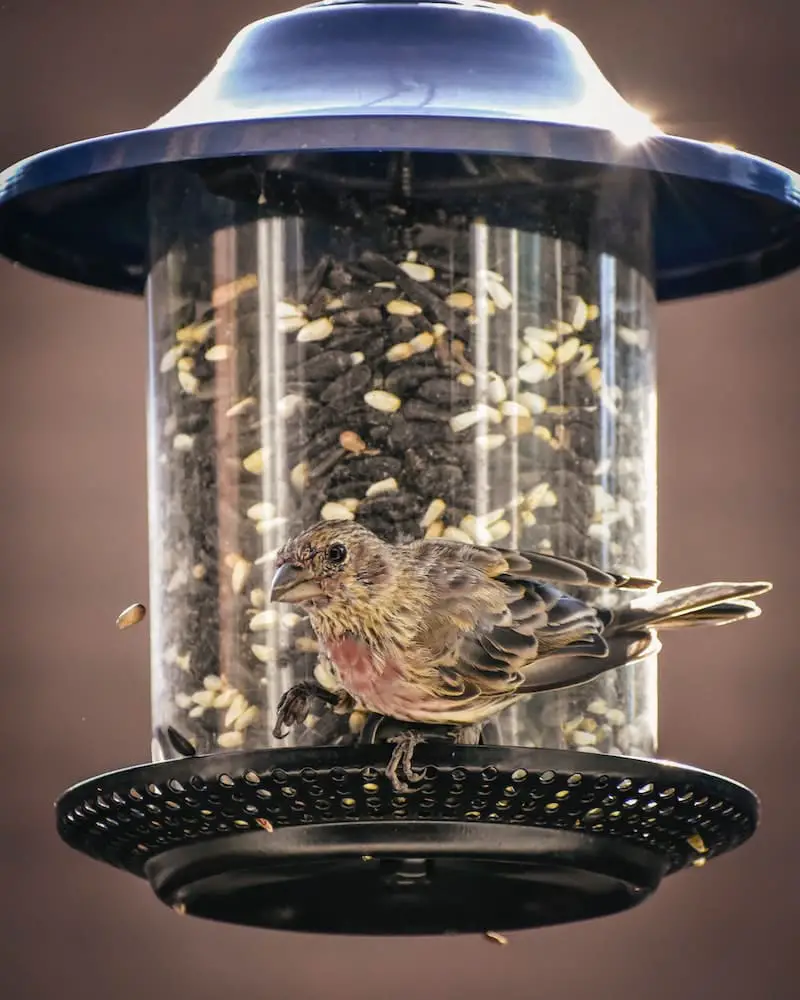
It is important to consider how best to feed thistle seeds to finches for optimum health and nutrition.
To get the most nutrition from this food source, make sure to buy unhulled varieties of thistle seeds so that birds can hold the seed firmly in their beaks while they nibble away at both the hull and the seed itself.
The finches’ diet should also include fresh vegetables, such as spinach or carrots, and fruits, such as apples or pears.
When feeding a variety of foods to finches, it is important not to feed too much of any one item; mix several different types of seeds and fresh foods into each feeding.
For convenience, many bird enthusiasts purchase pre-made mixtures specifically marketed for finches and other small birds. Taking care that finches have a balanced diet is essential for them to live long, healthy lives.
How to Pick Finch Seeds?
Choosing the right finch seed for your pet bird can be a difficult decision. One thing to consider is what type of seeds your finch prefers. Some common options include millet, canary, and safflower.
You should also think about whether you want to mix different types of seeds or if one type on its own would suffice for your pet.
It’s important to look for high-quality seeds that are free from mold or other contaminants. Otherwise, they won’t be as nutritious or beneficial to their health.
Lastly, when it comes to selecting seed size, it’s best to choose smaller sizes since most finches prefer small seeds over larger ones.
With these few easy tips, you should have no problem finding the best finch seed option for your feathered friend!
Can I Put My Finch Feeders Out All Year Long?
If you’re a bird or finch enthusiast, you know the joys of putting up feeders and watching the birds flock to enjoy a meal.
However, if you’re wondering whether it’s safe to keep your finch feeders out all year long, research suggests that it can depend on the species of birds in your area.
In some cases, certain birds may be able to find enough food through other sources and attract fewer individuals to your feeders in the off-season.
On the other hand, other birds may not be able to switch their diets as easily or have access to an adequate food supply without them.
Even if you are in an area that does experience cold winters, it is important to ensure that you replace any food that might spoil due to conditions brought on by extreme weather.
All in all, there is no definitive answer as each species of bird and region will vary, but doing plenty of research beforehand can certainly assist those wishing for their feathered visitors all year round!
How to Attract Finches to a Thistle Feeder?
Attracting your winged friends to a thistle feeder can be a rewarding experience. The best way to make finches flock to your thistle feeder is by offering them a good source of sustenance, which they can easily access.
To ensure you’re providing the right combination of bird food, try using high-quality thistle seed, as it will attract more finches. Additionally, it’s important to place the thistle feeder in a location that finches feel comfortable visiting.
If possible, choosing an area near trees and shrubs will provide birds with refuge from predators while they eat. Finally, remember that variety is key!
Offering different seeds beyond thistle will increase the likelihood of seeing more wild birds at your feeder. With these tips in mind, you’ll soon have beautiful finches frequenting your yard and bringing life to your outdoor space.
1. Keep It Fresh
Thistle feeders are a great way to attract finches, providing them with fresh seeds for them to snack on. Luckily, these feeders can be easily filled and refilled with thistle seed to keep it fresh and tasty for finches.
When setting up your feeder, make sure you have a good location so you can witness the beauty of the finches as they enjoy their meal.
To take it one step further, if you happen to live in an area where finches are not plentiful, you could also put out some water or create a bit of shelter in order to draw more interest from nearby birds.
2. Use the Right Seed
If you want to attract finches to your thistle feeder, using the right type of seed can make all the difference.
Selecting a quality finch-specific seed blend is essential as it will contain the tiny seeds that finches love, such as thistle, Nyjer, and sunflower chips.
Keep in mind that not all birds will like each type of food, so there are bound to be some new arrivals that don’t seem interested in your offered meal.
It’s a good idea to experiment by adding different mixes and adjusting your feeder accordingly until you find the combination which attracts the most diversity.
Not only is it positively rewarding to see a flurry of bird activity at your feeder, but also you are helping them get through cold winters and reduce stress when it comes time for the breeding season. So go ahead and show those finches what kind of host you are.
3. Keep the Finch Feeder Clean
Cleaning a feeder to attract finches is an essential part of getting them to flock to the area. Birds are attracted to the smell and sight of a clean feeder, particularly the inviting thistle feeders that they prefer.
It’s important to keep the feeder cleaned from any buildup, debris, or residues from other birds or animals so that you can ensure there will be finches visiting.
To help protect the birds and ensure their well-being, washing out the thistle feeders periodically and refilling them with fresh seed after doing so is a great way to ensure that you’ll get plenty of finches for your gardens.
4. Add Colors and Vegetation to Your Backyard
Having a thistle feeder in your backyard is one of the best ways to attract finches, but did you know that adding colors and greenery can help draw even more finches to your yard?
Planting a variety of native shrubs, trees, and grasses can make your feeder a destination spot for finches.
Go for choosing both flowering and non-flowering plants that have varied shapes, colors, and textures. You might also hang up some brightly colored seeds (such as sunflower) in mesh netting or cut colorful paper into strips and suspend it near the feeder.
The colors of the plantings will attract more birds while the vegetation will provide them with safe cover. So go ahead and give your backyard an inviting touch to encourage a flock of finches to make their home nearby.
5. Remove Other Bird Feeders Temporarily
Have you ever wanted to attract finches to a thistle feeder in your backyard? Removing any other bird feeders temporarily can increase the likelihood of finches coming to your feeder.
Finches are especially attracted to thistle-infused seed, so by providing that source exclusively, the birds may be enticed to your space.
Additionally, adding some cover and areas for nesting spots may also draw even more feathered friends to your backyard. Applying these simple steps can help bring a variety of beautiful birds and different species into your surroundings.
6. Put Finch Feeders in Safe Locations
Put a thistle feeder out in your backyard in a safe and secure location to attract finches.
Installing feeders correctly is crucial for success, as finches prefer feeders that provide safety from possible predators.
Be sure to place the feeder in a site with overhead cover and out of reach of cats, squirrels, and other animals that may come into your yard.
You should also position it away from windowed or enclosed porches or patios to reduce the risk of window collisions.
You’ll be able to watch your feathered friends gather around their new hangout as well as enjoy the soothing environment created by their soft chirps.
FAQs
When it comes to providing food for finches, many people opt to put out thistle seeds. This is a great choice due to the fact that thistle seeds are highly nutritional, and the birds love them.
However, there can be a few complications when it comes to supplying the seed. Birds might try to compete over a certain spot in the yard where the seed is located, which could lead to fighting.
Also, frequently replenishing the thistle seed can become costly and labour-intensive as it needs to be done every week or so.
While adding feeders and special hooks can help deter theft from other animals, mold and germination of old thistle seeds can also pose potential issues for your feathered friends.
As such, keeping an eye on your finch feeder is important in order to ensure that the whole process runs smoothly with no hiccups along the way.
Do finches prefer thistle or Nyjer seed?
Finches are a popular pet choice due to their beautiful song, interesting colors, and hardy nature.
Many owners of these delightful birds are often unsure which bird seed they should opt for in order to keep their feathered friends happy.
One of the most commonly asked questions is whether finches prefer thistle or Nyjer seed; it turns out that the answer depends on the individual bird, as some may show a preference towards either one.
Generally speaking, finches enjoy both types of seed since they offer a range of nutrients needed for their well-being.
What matters most is finding high-quality seeds that contain essential vitamins, minerals, and other important supplements required for proper growth and development; after all, a healthy and well-nourished bird will always be more vibrant, agile, and happier.
Do finches eat thistle seed in the winter?
Finches are a hearty breed of bird that manage to obtain food during the winter months. But, you may be wondering whether these small birds consume thistle seed as part of their winter diet. Its answer is both yes and no.
Certain species of finches may eat thistle seeds, while others rely more heavily on vegetable matter, such as berries and grains found in bird seed mixtures.
Thistle seeds can provide sustenance for finches, but different species prefer certain food sources at certain times of the year.
Therefore, depending on where you live and what type of finch is inhabiting your area, it’s possible that thistle seeds will make up part of their winter diet.
Why won’t finches come to my thistle feeder?
Finches are some of the most common visitors to thistle feeders, but they can be tricky to attract.
Wild finches frequent ever-changing food sources, so if there isn’t a reliable source of food nearby, you may need to give them more incentive to visit your feeder.
In addition, a finch’s diet consists mainly of weed seeds and buds, so filling the feeder with thistle seeds alone may not be enough. Try offering a mix of sunflower and nyjer seeds as well.
Lastly, installing a hummingbird feeder near yours may attract small birds, but don’t forget to maintain it regularly! With the right resources and some patience, your thistle feeder should become an active gathering place for all sorts of colorful feathered friends.
How do finches eat thistle seed?
Finches are adept at getting the most out of thistle seed. To begin with, they use their sharp beaks to crack the hard outer shell and get to the nutritious seed inside.
Additionally, unlike many other birds, some finches have a unique adaptation that enables them to tuck away portions of food into pockets located in their throats; this allows them to store up the food so that they can eat bite-sized snacks as needed throughout the day.
Finally, finches also create messes as part of their eating habits. They often drop portions of uneaten thistle seed from their mouths onto the ground below, a process which helps spread thistle seeding and thus propagate entire new populations!
Final words
Spring is the best time to put out thistle seed for finches. By doing this, you will be providing them with a food source early in the season so they can start breeding right away.
This will also help increase their population, which can only be good for the environment.
So if you’re looking to do something good for nature, putting out thistle seed for finches in the spring is a great way to start!
You will also enjoy reading:





